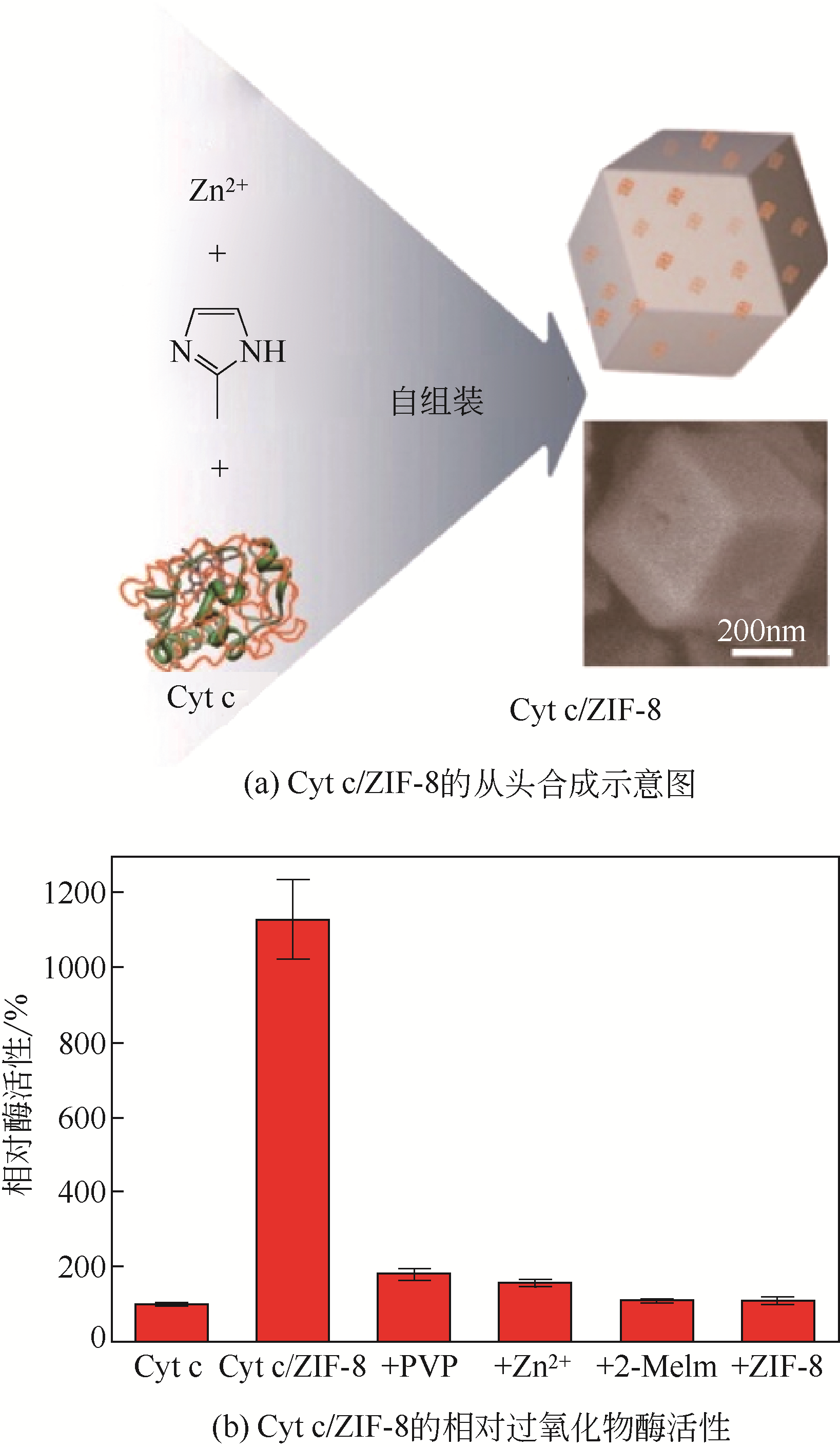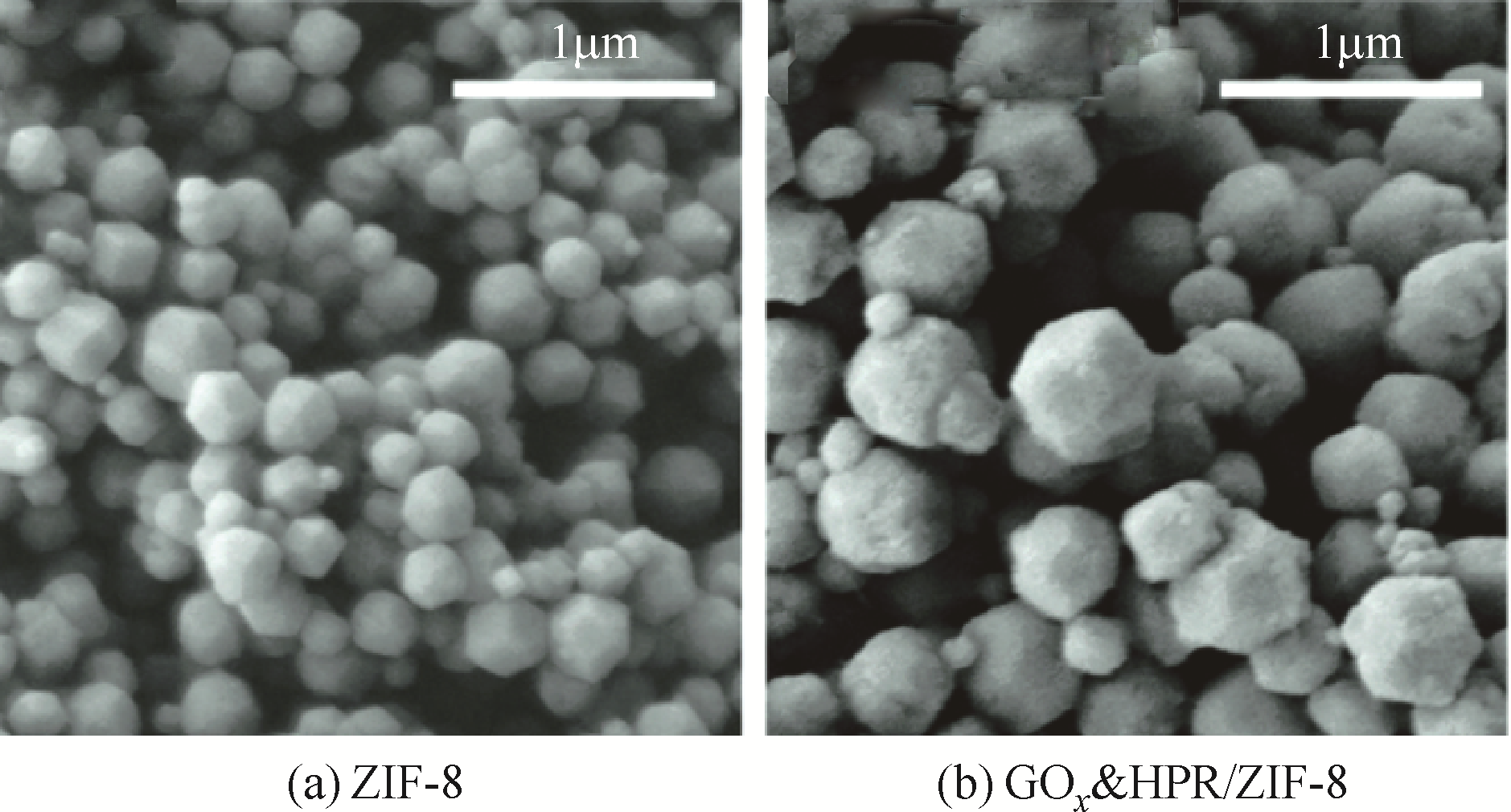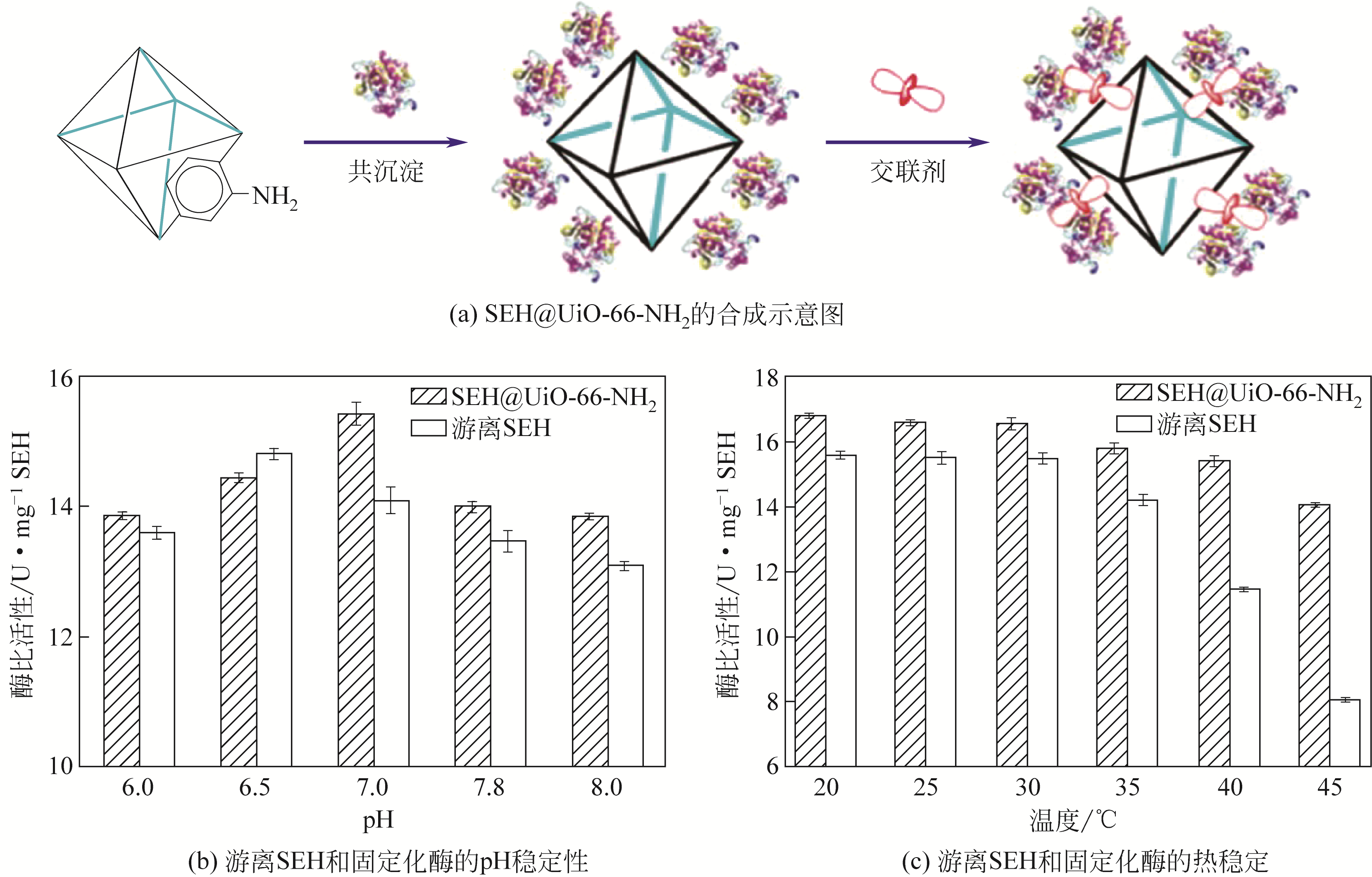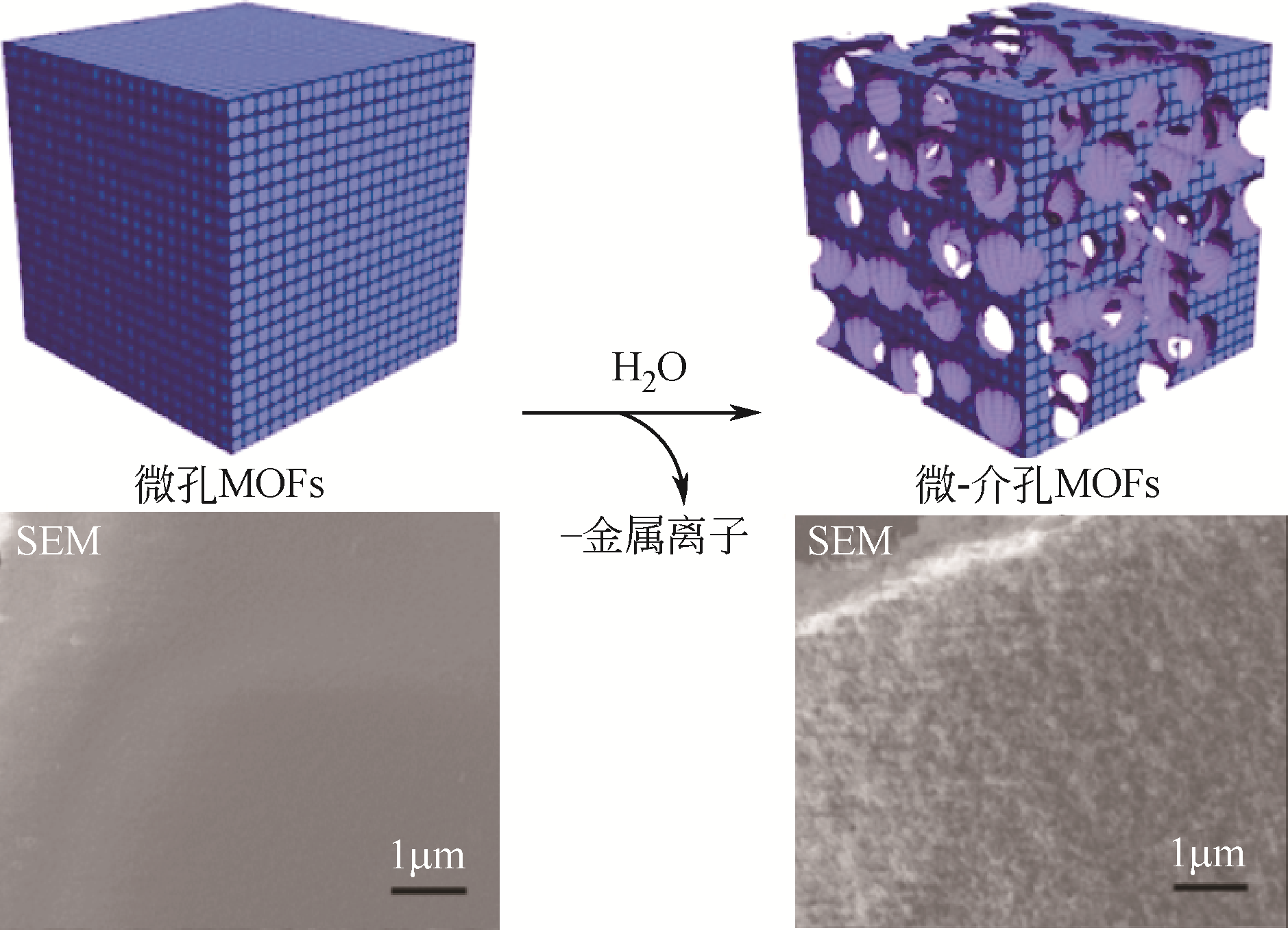Chemical Industry and Engineering Progress ›› 2019, Vol. 38 ›› Issue (06): 2889-2897.DOI: 10.16085/j.issn.1000-6613.2018-1883
• Biochemical and pharmaceutical engineering • Previous Articles Next Articles
Immobilization of enzymes on metal-organic frameworks and its application in environmental fields
Tingting XIE( ),Lina CHI(
),Lina CHI( ),Ruiting LIU,Xinze WANG
),Ruiting LIU,Xinze WANG
- School of Environmental Science and Engineering, Shanghai Jiao Tong University, Shanghai 200240, China
-
Received:2018-09-19Online:2019-06-05Published:2019-06-05 -
Contact:Lina CHI
金属有机框架固定化酶及其在环境中的应用
- 上海交通大学环境科学与工程学院,上海 200240
-
通讯作者:迟莉娜 -
作者简介:解婷婷(1990—),女,硕士研究生,研究方向为酶的固定化和酶膜的制备。E-mail:<email>qq1006420052@sjtu.edu.cn</email>。 -
基金资助:国家水体污染控制与治理科技重大专项(2017ZX07203-005);国家自然科学基金(21737002)
CLC Number:
Cite this article
Tingting XIE, Lina CHI, Ruiting LIU, Xinze WANG. Immobilization of enzymes on metal-organic frameworks and its application in environmental fields[J]. Chemical Industry and Engineering Progress, 2019, 38(06): 2889-2897.
解婷婷, 迟莉娜, 刘瑞婷, 王欣泽. 金属有机框架固定化酶及其在环境中的应用[J]. 化工进展, 2019, 38(06): 2889-2897.
share this article
Add to citation manager EndNote|Ris|BibTeX
URL: https://hgjz.cip.com.cn/EN/10.16085/j.issn.1000-6613.2018-1883
| 合成方法 | 酶 | 酶的尺寸/? | MOFs | MOFs孔径/? | 固载机理 | 参考文献 |
|---|---|---|---|---|---|---|
| 从头合成 | CAT | 约100 | ZIF-90 | 11.2 | 载体包埋 | [ |
| Cyt c | 约26×32×33 | ZIF-8 | 11.6 | 载体包埋 | [ | |
| GOx&HPR | — | ZIF-8 | 11.6 | 载体包埋 | [ | |
| CPO | — | ZIF-8 | 11.6 | 载体包埋 | [ | |
| BHb | — | ZIF-8 | 11.6 | 载体包埋 | [ | |
| 后合成 | HPR | 约40×44×68 | IPD-mesoMOF-3 | 150~500 | 表面吸附 | [ |
| Lac-T | 约65×55×45 | Zr-MOF | 35~70 | 表面吸附 | [ | |
| GDH | — | ZIF-70 | — | 表面吸附 | [ | |
| MP-11 | 约33×17×11 | [Cu(BPDC) (DABCO)] n | 22×9 | 表面吸附 | [ | |
| Try | — | MILL-88B-NH2(Cr) | — | 共价键连接 | [ | |
| CAL-B | — | IRMOF-3 | 11.2, 14.5 | 共价键连接 | [ | |
| SEH | — | UiO-66-NH2 | 8.5 | 共价键连接 | [ | |
| OPAA | 约78×44×44 | PCN-128y | 44 | 孔道扩散 | [ | |
| MP-11 | 约33×17×11 | Tb-mesoMOF | 9, 30, 41 | 孔道扩散 | [ | |
| Cyt c | 约26×32×33 | POST-66(Y) | 30~200 | 孔道扩散 | [ | |
| HPR | 约40×44×68 | POST-66(Y) | 30~200 | 孔道扩散 | [ |
| 合成方法 | 酶 | 酶的尺寸/? | MOFs | MOFs孔径/? | 固载机理 | 参考文献 |
|---|---|---|---|---|---|---|
| 从头合成 | CAT | 约100 | ZIF-90 | 11.2 | 载体包埋 | [ |
| Cyt c | 约26×32×33 | ZIF-8 | 11.6 | 载体包埋 | [ | |
| GOx&HPR | — | ZIF-8 | 11.6 | 载体包埋 | [ | |
| CPO | — | ZIF-8 | 11.6 | 载体包埋 | [ | |
| BHb | — | ZIF-8 | 11.6 | 载体包埋 | [ | |
| 后合成 | HPR | 约40×44×68 | IPD-mesoMOF-3 | 150~500 | 表面吸附 | [ |
| Lac-T | 约65×55×45 | Zr-MOF | 35~70 | 表面吸附 | [ | |
| GDH | — | ZIF-70 | — | 表面吸附 | [ | |
| MP-11 | 约33×17×11 | [Cu(BPDC) (DABCO)] n | 22×9 | 表面吸附 | [ | |
| Try | — | MILL-88B-NH2(Cr) | — | 共价键连接 | [ | |
| CAL-B | — | IRMOF-3 | 11.2, 14.5 | 共价键连接 | [ | |
| SEH | — | UiO-66-NH2 | 8.5 | 共价键连接 | [ | |
| OPAA | 约78×44×44 | PCN-128y | 44 | 孔道扩散 | [ | |
| MP-11 | 约33×17×11 | Tb-mesoMOF | 9, 30, 41 | 孔道扩散 | [ | |
| Cyt c | 约26×32×33 | POST-66(Y) | 30~200 | 孔道扩散 | [ | |
| HPR | 约40×44×68 | POST-66(Y) | 30~200 | 孔道扩散 | [ |
| 1 | KAUSHAL J , MEHANDIA S , SINGH G , et al . Catalase enzyme: application in bioremediation and food industry[J]. Biocatalysis and Agricultural Biotechnology, 2018, 16: 192-199. |
| 2 | PELLIS A , SILVESTRINI L , SCAINI D , et al . Enzyme-catalyzed functionalization of poly (L-lactic acid) for drug delivery applications[J]. Process Biochemistry, 2017, 59: 77-83. |
| 3 | 杨杰, 张玉彬, 吴梧桐 . 固定化酶技术及其在医药上的应用新进展[J]. 药物生物技术, 2013, 20(6): 553-556. |
| YANG J , ZHANG Y B , WU W T . Technique of immobilized enzyme and its application in medicine[J]. Pharmaceutical Biotechnology, 2013, 20(6): 553-556. | |
| 4 | NELSON J M , GRIFFIN E G . Adsorption of invertase[J]. Journal of the American Chemical Society, 1916, 38(5): 1109-1115. |
| 5 | 丁齐, 邢晓东, 李丽霞 . 多孔半互穿温敏水凝胶点击反应固定化酶[J]. 化工进展, 2014, 33(4): 971-976. |
| DING Q , XING X D , LI L X . Enzyme immobilization on porous semi-interpenetrating thermosensitive hydrogel carriers via thiol-based click reaction[J]. Chemical Industry and Engineering Progress, 2014, 33(4): 971-976. | |
| 6 | PANDEY V P , RANI J , JAISWAL N , et al . Chitosan immobilized novel peroxidase from Azadirachta indica: characterization and application[J]. International Journal of Biological Macromolecules, 2017, 104: 1713-1720. |
| 7 | BERNINI F , CASTELLINI E , BERTO M , et al . Solvent tunes the peroxidase activity of cytochrome c immobilized on kaolinite[J]. Applied Clay Science, 2015, 118: 316-324. |
| 8 | 张笛, 邓满凤, 赵赫, 等 . 多巴胺包埋磁性SiO2固定化漆酶催化去除4-氯酚[J]. 化工学报, 2015, 66(9): 3705-3711. |
| ZHANG D , DENG M F , ZHAO H , et al . Immobilization of laccase on magnetic SiO2 through dopamine self-polymerization for 4-CP removal[J].CIESC J., 2015, 66(9): 3705-3711. | |
| 9 | ZHOU L , WANG C , JIANG Y , et al . Immobilization of papain in biosilica matrix and its catalytic property[J]. Chinese Journal of Chemical Engineering, 2013, 21(6): 670-675. |
| 10 | 张义芹, 王正, 唐爱星, 等 . 功能化碳纳米管固定化脂肪酶的制备及其合成生物柴油研究[J]. 可再生能源, 2016, 34(9): 1411-1416. |
| ZHANG Y Q , WANG Z , TANG A X , et al . Immobilization of lipase on functionalized multi-walled carbon nanotubes for biodiesel preparation[J]. Renewable Energy Resources, 2016, 34(9): 1411-1416. | |
| 11 | MOHAMED S A , AL-HARBI M H , ALMULAIKY Y Q , et al . Immobilization of horseradish peroxidase on Fe3O4 magnetic nanoparticles[J]. Electronic Journal of Biotechnology, 2017, 27: 84-90. |
| 12 | LONG J , ZHANG B , LI X , et al . Effective production of resistant starch using pullulanase immobilized onto magnetic chitosan/Fe3O4 nanoparticles[J]. Food Chemistry, 2018, 239: 276-286. |
| 13 | ZHANG W , QIU J , FENG H , et al . Increase in stability of cellulase immobilized on functionalized magnetic nanospheres[J]. Journal of Magnetism & Magnetic Materials, 2015, 375: 117-123. |
| 14 | HUDSON S , COONEY J , MAGNER E . Proteins in mesoporous silicates[J]. Angewandte Chemie, 2010, 47(45): 8582-8594. |
| 15 | LI P , MOON S Y , GUELTA M A , et al . Encapsulation of a nerve agent detoxifying enzyme by a mesoporous zirconium metal-organic framework engenders thermal and long-term stability[J]. Journal of the American Chemical Society, 2016, 138(26): 8052-8055. |
| 16 | SHIH Y H , LO S H, YANG N S , et al . Trypsin-immobilized metal-organic framework as a biocatalyst in proteomics analysis[J]. ChemPlusChem, 2012, 77(11): 982-986. |
| 17 | MA W, JIANG Q , YU P , et al . Zeolitic imidazolate framework-based electrochemical biosensor for in vivo electrochemical measurements[J]. Analytical Chemistry, 2013, 85(15): 7550-7557. |
| 18 | 田运齐, 吴小芳, 侯文颖, 等 . 辣根过氧化物酶在MOF上的固定化研究[J]. 辽宁师范大学学报(自然科学版), 2016, 39(3): 373-376. |
| TIAN Y Q , WU X F , HOU W Y , et al . Immobilization of horseradish peroxidase on the metal-organic framework[J]. Journal of Liaoning Normal University, 2016, 39(3): 373-376. | |
| 19 | KIM Y, YANG T , YUN G , et al . Hydrolytic transformation of microporous metal-organic frameworks to hierarchical micro- and mesoporous MOFs[J]. Angewandte Chemie, 2015, 127(45): 13273-13278. |
| 20 | JIANG D , XU P , WANG H , et al . Strategies to improve metal organic frameworks photocatalyst’s performance for degradation of organic pollutants[J]. Coordination Chemistry Reviews, 2018, 376: 449-466 |
| 21 | KADHOM M , DENG B . Metal-organic frameworks (MOFs) in water filtration membranes for desalination and other applications[J]. Applied Materials Today, 2018, 11: 219-230. |
| 22 | CUI L , WU J , LI J , et al . Electrochemical sensor for lead cation sensitized with a DNA functionalized porphyrinic metal-organic framework[J]. Analytical Chemistry, 2015, 87(20): 10635-10641. |
| 23 | XU H , AGUILAR Z P , YANG L , et al . Antibody conjugated magnetic iron oxide nanoparticles for cancer cell separation in fresh whole blood[J]. Biomaterials, 2011, 32(36): 9758-9765. |
| 24 | LIÉDANA N , GALVE A , RUBIO C , et al . CAF@ZIF-8: one-step encapsulation of caffeine in MOF[J]. ACS Applied Materials & Interfaces, 2012, 4(9): 5016-5021. |
| 25 | LU W . Tuning the structure and function of metal-organic frameworks via linker design[J]. Chemical Society Reviews, 2014, 43(16): 5561-5593. |
| 26 | HINTZ H , WUTTKE S . Postsynthetic modification of an amino-tagged MOF using peptide coupling reagents: a comparative study[J]. Chemical Communications, 2014, 50(78): 11472-11475. |
| 27 | GKANIATSOU E , SICARD C , RICOUX R , et al . Metal-organic frameworks: a novel host platform for enzymatic catalysis and detection[J]. Materials Horizons, 2017, 4(1): 55-63. |
| 28 | CAO L , LANGEN L V , SHELDON R A . Immobilized enzymes: carrier-bound or carrier-free?[J]. Current Opinion in Biotechnology, 2003, 1(4): 387-394. |
| 29 | SHIEH F K , WANG S C , YEN C I, et al . Imparting functionality to biocatalysts via embedding enzymes into nanoporous materials by a de novo approach: size-selective sheltering of catalase in metal-organic framework microcrystals[J]. Journal of the American Chemical Society, 2015, 137(13): 4276-4279. |
| 30 | LÜ F , ZHANG Y , ZARE R N , et al . One-pot synthesis of protein-embedded metal-organic frameworks with enhanced biological activities[J]. Nano Letters, 2014, 14(10): 5761-5765. |
| 31 | WU X , GE J , YANG C , et al . Facile synthesis of multiple enzyme-containing metal-organic frameworks in a biomolecule-friendly environment[J]. Chemical Communications, 2015, 51(69): 13408-13411. |
| 32 | 赵睿南, 胡满成, 李淑妮, 等 . 基于金属有机骨架的固定化氯过氧化物酶的制备和性能评价[J]. 化学学报, 2017, 75(3): 293-299. |
| ZHAO R N , HU M C , LI S N , et al . Immobilization of chloroperoxidase in metal organic framework and its catalytic performance[J]. Acta Chimica Sinica, 2017, 75(3): 293-299. | |
| 33 | YIN Y , CHEN L G , QI X , et al . Protein-metal organic framework hybrid composites with intrinsic peroxidase-like activity as a colorimetric biosensing platform[J]. ACS Appl. Mater. Interfaces, 2016, 8(42): 29052-29061. |
| 34 | PANG S , WU Y , ZHANG X , et al . Immobilization of laccase via adsorption onto bimodal mesoporous Zr-MOF[J]. Process Biochemistry, 2016, 51(2): 229-239. |
| 35 | PISKLAK T J , MACÍAS M , COUTINHO D H , et al . Hybrid materials for immobilization of MP-11 catalyst[J]. Topics in Catalysis, 2006, 38(4): 269-278. |
| 36 | JUNG S , KIM Y, KIM S J, et al . Bio-functionalization of metal-organic frameworks by covalent protein conjugation[J]. Chemical Communications, 2011, 47(10): 2904-2906. |
| 37 | CAO S L , YUE D M , LI X H , et al . Novel nano-/micro-biocatalyst: soybean epoxide hydrolase immobilized on UiO-66-NH2 MOF for efficient biosynthesis of enantiopure (R)-1, 2-octanediol in deep eutectic solvents[J]. ACS Sustainable Chemistry & Engineering, 2016, 4(6): 3586-3595. |
| 38 | LYKOURINOU V , CHEN Y , WANG X-S , et al . Immobilization of MP-11 into a mesoporous metal-organic framework, MP-11@mesoMOF: a new platform for enzymatic catalysis[J]. Journal of the American Chemical Society, 2011, 133(27): 10382-10385. |
| 39 | ZHU Q , ZHUANG W , CHEN Y , et al . Nano-biocatalysts of Cyt c@ZIF-8/GO composites with high recyclability via a de novo approach[J]. ACS Appl. Mater. Interfaces, 2018, 10(18): 16066-16076. |
| 40 | HERNANDEZ K , FERNANDEZ-LAFUENTE R . Control of protein immobilization: coupling immobilization and site-directed mutagenesis to improve biocatalyst or biosensor performance[J]. Enzyme & Microbial Technology, 2011, 48(2): 107-122. |
| 41 | CHEN Y , LYKOURINOU V , HOANG T , et al . Size-selective biocatalysis of myoglobin immobilized into a mesoporous metal-organic framework with hierarchical pore sizes[J]. Inorganic Chemistry, 2012, 51(17): 9156-9158. |
| 42 | WANG Q , LIAN X , FANG Y , et al . Applications of immobilized bio-catalyst in metal-organic frameworks[J]. Catalysts, 2018, 8(4): 166-176. |
| 43 | 刘秀红, 常雁红, 罗晖 . 环境领域中固定化酶的应用[J]. 安徽农业科学, 2014, 42(21): 7171-7174. |
| LIU X H , CHANG Y H , LUO H . Applications of the immobilized enzyme in environmental fields[J]. Journal of Anhui Agricultural Sciences, 2014, 42(21): 7171-7174. | |
| 44 | WANG X , LU X , WU L , et al . 3D metal-organic framework as highly efficient biosensing platform for ultrasensitive and rapid detection of bisphenol A[J]. Biosensors and Bioelectronics, 2015, 65: 295-301. |
| 45 | LU X , WANG X , WU L , et al . Response characteristics of bisphenols on a metal-organic framework-based tyrosinase nanosensor[J]. ACS Applied Materials & Interfaces, 2016, 8(25): 16533-16539. |
| 46 | ZHANG T , WANG L , GAO C , et al . Hemin immobilized into metal-organic frameworks as an electrochemical biosensor for 2,4,6-trichlorophenol[J]. Nanotechnology, 2018, 29(7): 074003. |
| 47 | DONG S , ZHANG D , SUO G , et al . Exploiting multi-function metal-organic framework nanocomposite Ag@Zn-TSA as highly efficient immobilization matrixes for sensitive electrochemical biosensing[J]. Analytica Chimica Acta, 2016, 934: 203-211. |
| 48 | 庞仕龙 . 介孔金属有机骨架复合材料固定化漆酶及应用[D]. 北京:北京林业大学, 2016. |
| PANG S L . Immobilization of laccase onto mesoporous MOFs composite and the application of immobilized laccase[D]. Beijing: Beijing Forestry University, 2016. | |
| 49 | 李小娟, 何长发, 黄斌, 等 . 金属有机骨架材料吸附去除环境污染物的进展[J]. 化工进展, 2016, 35(2): 586-594. |
| LI X J , HE C F , HUANG B , et al . Progress in the applications of metal-organic frameworks in adsorption removal of hazardous materials[J]. Chemical Industry and Engineering Progress, 2016, 35(2): 586-594. |
| [1] | YANG Xiazhen, PENG Yifan, LIU Huazhang, HUO Chao. Regulation of active phase of fused iron catalyst and its catalytic performance of Fischer-Tropsch synthesis [J]. Chemical Industry and Engineering Progress, 2023, 42(S1): 310-318. |
| [2] | LI You, WU Yue, ZHONG Yu, LIN Qixuan, REN Junli. Pretreatment of wheat straw with acidic molten salt hydrate for xylose production and its effect on enzymatic hydrolysis efficiency [J]. Chemical Industry and Engineering Progress, 2023, 42(9): 4974-4983. |
| [3] | PAN Yichang, ZHOU Rongfei, XING Weihong. Advanced microporous membranes for efficient separation of same-carbon-number hydrocarbon mixtures: State-of-the-art and challenges [J]. Chemical Industry and Engineering Progress, 2023, 42(8): 3926-3942. |
| [4] | CHEN Na, ZHANG Xiaojing, ZHANG Nan, MA Bingbing, ZHANG Han, YANG Haojie, ZHANG Hongzhong. Effect of quenching enzymes on partial nitrification-mixed autotrophic nitrogen removal system [J]. Chemical Industry and Engineering Progress, 2023, 42(7): 3816-3823. |
| [5] | LU Shaojie, LIU Jia, JI Qianzhu, LI Ping, HAN Yueyang, TAO Min, LIANG Wenjun. Preparation of diatomaceous earth-based composite filler and its xylene removal performance by a biotrickling filter [J]. Chemical Industry and Engineering Progress, 2023, 42(7): 3884-3892. |
| [6] | QIN Kai, YANG Shilin, LI Jun, CHU Zhenyu, BO Cuimei. A Kalman filter algorithm-based high precision detection method for glucoamylase biosensors [J]. Chemical Industry and Engineering Progress, 2023, 42(6): 3177-3186. |
| [7] | ZHANG Yaodan, SUN Ruoxi, CHEN Pengcheng. Advances of multi-enzyme co-immobilization carrier based on cascade reactions [J]. Chemical Industry and Engineering Progress, 2023, 42(6): 3167-3176. |
| [8] | ZHU Yajing, XU Yan, JIAN Meipeng, LI Haiyan, WANG Chongchen. Progress of metal-organic frameworks for uranium extraction from seawater [J]. Chemical Industry and Engineering Progress, 2023, 42(6): 3029-3048. |
| [9] | YUE Xin, LI Chunying, SUN Dao’an, LI Jiangwei, DU Yongmei, MA Hui, LYU Jian. Progress on heterogeneous catalysts for cyclopropanation of diazo compounds [J]. Chemical Industry and Engineering Progress, 2023, 42(5): 2390-2401. |
| [10] | MAO Menglei, MENG Lingding, GAO Rui, MENG Zihui, LIU Wenfang. Research progress on enzyme immobilization on porous framework materials [J]. Chemical Industry and Engineering Progress, 2023, 42(5): 2516-2535. |
| [11] | ZHANG Jinhui, ZHANG Huan, ZHU Xinfeng, SONG Zhongxian, KANG Haiyan, LIU Hongpan, DENG Wei, HOU Guangchao, LI Guiting, HUANG Zhenzhen. Research progress of UiO-66 materials for adsorption and photocatalytic oxidation of typical organic compounds [J]. Chemical Industry and Engineering Progress, 2023, 42(1): 445-456. |
| [12] | GAO Weitao, YIN Qinan, TU Ziqiang, GONG Fan, LI Yang, XU Hong, WANG Cheng, MAO Zongqiang. Proton transport in metal-organic frameworks and their applications in proton exchange membranes [J]. Chemical Industry and Engineering Progress, 2022, 41(S1): 260-268. |
| [13] | MENG Lingding, MAO Menglei, LIAO Qiyong, MENG Zihui, LIU Wenfang. Recent advance in stability of carbonic anhydrase and formate dehydrogenase [J]. Chemical Industry and Engineering Progress, 2022, 41(S1): 436-447. |
| [14] | PU Fulong, WU Shangwei, ZHENG Yingling, ZHENG Yuyi, HOU Xuedan. Effect of lignin extracted by lactic acid-based deep eutectic solvent from rice straw on cellulase hydrolysis efficiency [J]. Chemical Industry and Engineering Progress, 2022, 41(9): 4937-4945. |
| [15] | LIU Yali, ZHANG Hongwei, KANG Xiaorong. Effect and mechanisms of microplastics on anaerobic digestion of sludge [J]. Chemical Industry and Engineering Progress, 2022, 41(9): 5037-5046. |
| Viewed | ||||||
|
Full text |
|
|||||
|
Abstract |
|
|||||





